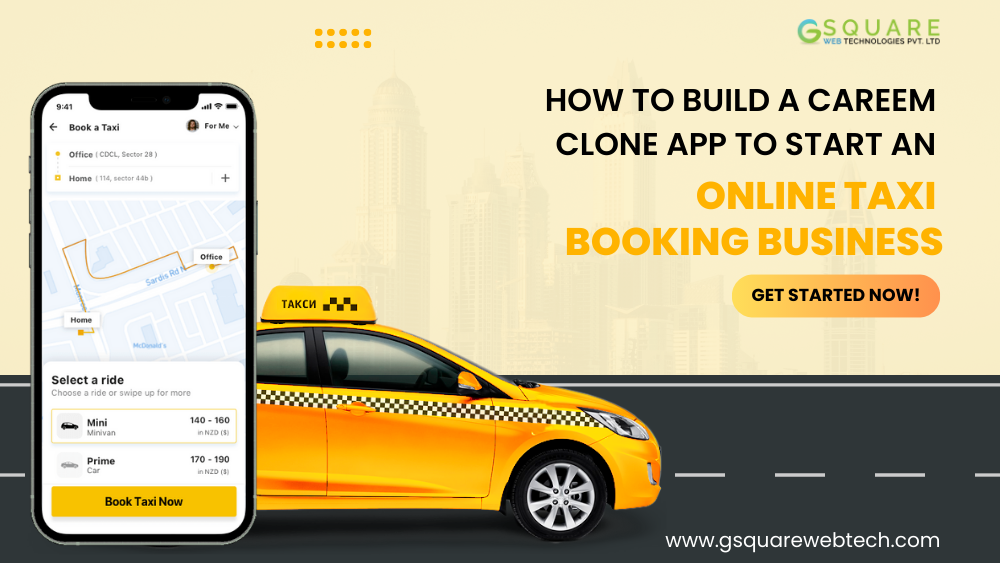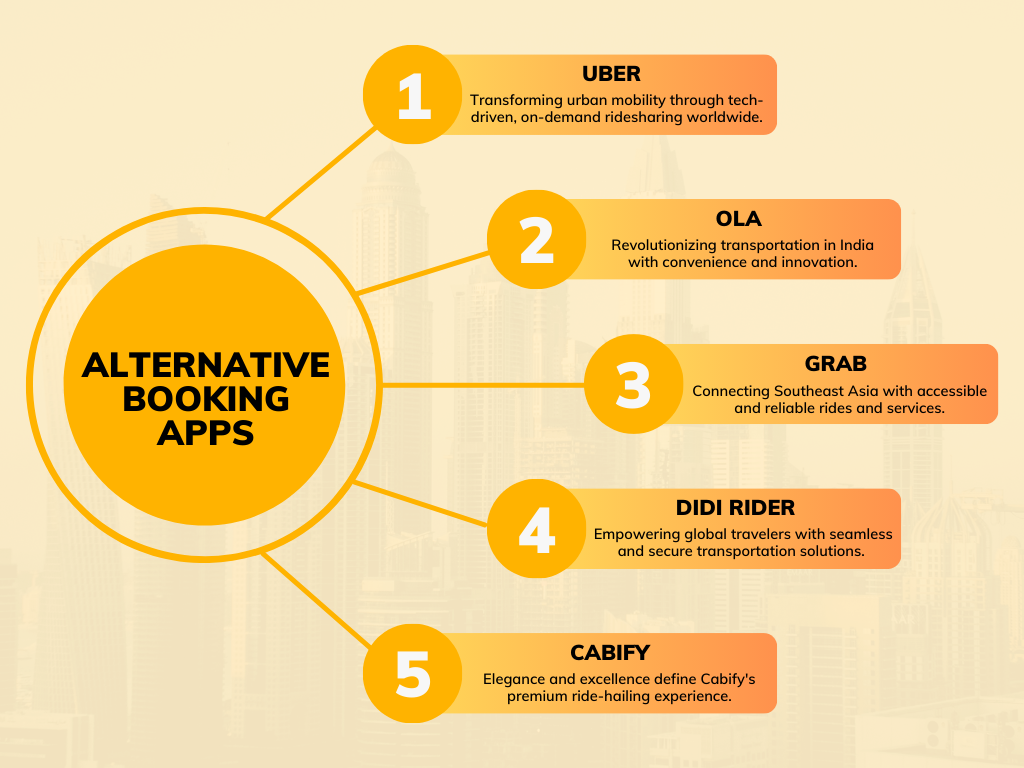
How to Build A Careem Clone App to Start an Online Taxi Booking Business?
Transport! is the only business in which you help your target audience reach their destination in real.
That is why they feel attached to your brand and keep it at the top of their contact list.
But wait… Can you (as a startup) start a transport business?
Well, in the current scenario – Yes!
With growing technology, it is now possible for even local-level businesses to reach the top of their local transport market, just like Careem did in the Middle East.
But How did Careem do this?
Simply, by leveraging the power of an APP!
That you can replicate in your local market.
We will know, in this piece of writing, how by building the Careem Clone App, you can kick-start a car-hailing business to grab your local transport market.
So, without wasting time let’s get started.
Why Build A Careem-Like Taxi App?
Let’s talk business, Why you should build a Careem-like App?
Well, the statistics below explain the reason!
The Taxi Business is on the way to becoming a buzz in the upcoming time.
According to Statista, revenue in the Ride-hailing and Taxi market is projected to reach US $312.60 billion in 2023. It is expected to show an annual growth rate (CAGR 2023-2027) of 3.55%, leading to a projected market volume of US $359.40 billion by 2027.
The number of users in the Ride-hailing and Taxi market is expected to amount to 1.45 billion users by 2027. Besides, the user penetration is expected to be 17.4% in 2023 and 18.3% by 2027, and the average revenue per is projected to amount to US $233.20.
Noteworthy, 55% of total revenue will be generated through online sales by 2027, making it essential to build a convenient taxi app to work seamlessly using online resources.
Being a business person you can understand the significance of this data.
How Does a Taxi App Work?
Without diving deeper into the technical part, let’s learn how a taxi app works.
1. Registration:
In the taxi app business, drivers play a pivotal role by heavily investing in buying a passenger vehicle. Once they own a vehicle they can register with the app to get rides.
On the other hand, passengers can start to avail of services offered by the app just by downloading it and filling in their name, contact information, and payment details in the prescribed online form in the app.
Noteworthy, drivers have to provide in-depth details of their track record and vehicle details, as it helps the app to ensure passengers’ safety.
2. Booking:
After duly filling in all the details and verification by the app, passengers can see a list of nearby drivers and start requesting a ride.
Once they request a ride and input their desired destination, the initial information flashes on their app screen such as nearby drivers with estimated fare and arrival time, vehicle type, and driver ratings. Passengers can select any from the list at their convenience.
On the other side, drivers regularly get notifications for each nearby requested ride, for this they must be online on the app.This is up to drivers whether they want to accept or reject the ride within a limited time, once the time is over the ride goes to the next available driver.
3. Confirmation:
Once a driver accepts the ride, the passenger receives a confirmation notification with details such as the driver’s name, photo, vehicle information, and estimated time of arrival along with a real-time tracking facility, so they can track the driver’s location and path while waiting.
Additionally, Passengers and drivers can communicate through the app for additional details (if required).
After completion of the ride, passengers can rate the driver and provide feedback on their behavior, positive or negative.This rating allows the driver with positive behavior to get further rides and passengers to find the track record of the drivers by finding the reviews and ratings from previous passengers.Drivers also have the option to rate the passengers ensuring increasing quality of ride on both sides.
4. Payment:
Now, come to the business part. After the ride is completed, the app automatically deducts the amount from the passenger’s wallet or they can pay cash, it depends on the payment method they select when requesting a ride.
Impressed with the driver’s good behavior, passengers can also add tips to the fare.
Once paid, the app sends a digital receipt via email to the email id of the passenger. This earning is further divided between the driver and the app, usually, apps charge 10 to 25 percent of the total fare as commission.
Careem Journey – At a Glance
Careem’s founders initially launched the business as a web-based service for corporate car bookings.
For the first three years, they ran it solely as a web-based platform. In 2015, they evolved it into a rideshare service by making it available as a car hire service for daily use.
USPs that set Careem apart:
1. B2B and B2C services are offered on the same platform
2. Two primary offers – Pre-booking and On-demand car hiring
3. Focused on local customer demand and positive user experience
Careem App Business Model as a Whole
Like most ridesharing companies, Careem also works on a commission-based earning model. Additionally, it also offers subscriptions to facilitate customers with exclusive discounts and free cancellation of the ride.
- Careem App For Drivers
Its business model is based on two modules, the Driver App and the Passenger App. Drivers can register on the app to get regular rides to earn and Careem gets a commission on each ride. Generally, this commission is 25% which drivers have to pay to Careem to carry on with the business and get regular bookings.
- Driver’s Training
To ensure passenger safety, when new drivers sign up for the Careem bookings they have to go through Captain training. After completion of the training and a successful first trip, they can start earning from Careem bookings by giving a certain amount in the form of a commission.
- Careem Service Locations
Careem is running the same business and revenue model in major cities around the Middle East, North Africa, Pakistan, and Turkey. Currently, it has a reach of up to 30 million people in the Middle East and the potential to reach the Middle East at large which contains a huge area where 578 million people are living.
Careem has a stronghold in major cities around the Middle East and countries where it serves like Dubai, Lahore, Karachi, Riyadh, Jeddah, Cairo, Beirut, Islamabad, Istanbul, and many more.
- Careem App For Customers
The services Careem offers to its customers are broadly divided into three categories – Now, Pre, and Regular. As the name suggests, customers can book a cab on the spot where they are. Additionally, they can make pre-booking to reserve a slot for busy hours. Also, they can hire a regular service where a dedicated slot is reserved for them. This allows them to commute daily without interruptions, even during Careem’s busy business hours.
- App Availability and Safety
Customers can download the Careem App from the Google Play Store or Apple Store. On-demand taxi hiring options offer customers more flexibility than traditional taxi services.Once customers select their pick-up and drop-off location, it also displays the fare estimate. To ensure passenger safety the App provides a real-time ride-tracking facility so passengers can just sit back and relax until they reach their destination.
- Payment Options
Payment options are made available and customized to align with local customers’ mindsets and spending behavior. Recognizing that technology adoption in the Middle East and its surrounding areas is not as advanced as in other countries, Careem designed its payment system accordingly.
Understanding that payment options that are prominent in the other technically advanced areas of the world may not work as effectively in the Middle East, Careem provided passengers with payment options including Cash, Credit Cards, and Credit in the wallet. Careem kept the cash payment option a priority to make the app more convenient locally.
- Cash Flow Monitoring System
Not surprisingly, more than 90% of the fare Careem receives is in the form of Cash payments. It allows drivers to receive all the money. However, they are required to pay Careem’s share as a commission.For smooth cash flow, the App has implemented a limit on the number of cash ride bookings per driver. Once a driver’s cash ride bookings reach the limit their account gets blocked and they don’t get further rides before paying Careem’s share. This ensures a seamless cash flow for both, drivers and the company.
- Nudge to Decrease Cash Payments
Despite local preferences, to decrease the number of cash rides and enable automatic commission deduction, Careem also offers a wallet credit service. It allows passengers to recharge their wallets to pay for Careem rides.In this scenario, passengers do not directly pay the drivers, instead, the fare amount gets deducted from their wallet and gets added to the Careem and driver’s account directly. This service makes the payment service faster and more secure.
- Feedback Option
To monitor drivers and the overall service quality, the Careem app provides a feedback and rating option for passengers. It helps them gauge the current satisfaction level of their passengers in the areas where they operate.
- Rewards System
Recognizing the local community mindset, Careem builds strategies accordingly. The company pays attention to finding new customers and maintaining loyal ones. To achieve this, Careem runs a reward system that allows passengers to earn free rides even without signing up for the app. Careem’s Gold Rewards, an upgraded version of the service, allow passengers to earn bonus points, exclusive offers, and priority support.
Alternative Booking Apps
However, Out of the Middle East Careem is not the only giant in this taxi booking business. There are other Ridesharing Apps that are also performing exceptionally well. Some of these include:

1. Uber
Uber is the most popular taxi booking app in the USA, its user base has reached over 500 million and increasing rapidly. Launched in 2009, Uber became a market-dominant player because of its advanced offering to make commuting more convenient.Through its on-demand service offering, Uber is changing the way people commute.
2. Ola
With over a 100 million user base, Ola is one efficient alternative taxi app. It was launched in 2010 and has since been providing various facilities, evolving over time to offer booking services for all ranges of commute options, from comfortable sedans to tuk-tuks.
To ensure the safety of users, Ola has provided passengers with features like real-time tracking and driver background verification.
3. Grab
With a prime user base in Singapore, Malaysia, Cambodia, Indonesia, and surrounding countries in South Asia, Grab is serving over 100 million users. The reason behind the popularity of this app is its convenient and secure rides that meet local community demands.
It further offers multiple categories including economy, premium, and carpooling that fulfill the requirements of passengers with different backgrounds, budgets, and preferences.
4. DiDi Rider
This is another taxi booking app with a different location. Beijing-based DiDi Rider was founded in 2012 and now is offering multiple services including taxis and private car booking to its 50+ million users.
One additional thing DiDi Rider emphasizes is the use of algorithms for route optimization that makes the rides cost-effective and fast. Over time, it expanded its services to food delivery, and bike sharing, stepping towards evolving into a super app.
5. Cabify
Most of the taxi booking app market share in Latin America is acquired by Cabify. Initiated its operations in 2011, Cabify is holding over 10 million user base. Along with Latin America, Cabify is also serving in Spain prominently. To ensure the safety of the passengers and provide them with a positive user experience, Cabify prioritizes screening and regular training of its drivers.
It also expanded its service to provide corporate transportation solutions that offer firms a cost-effective way to manage the daily travel and safety of their employees.
Suggested Read: How Trucking Dispatch Software is Changing the Game for Logistics
How to Build a Taxi App like Careem?
Building a taxi app like Careem, or based on any other business model, requires careful planning, development skills, and above all solid understanding of the local transportation industry. You can follow the steps below to start building a taxi app.
- Market Research and Business Plan
Firstly, do research on your target market and understand the current needs. Once done, research and understand the demographics and competition in your local market and create a business plan accordingly. To ensure success you must identify the unique selling points and opportunities in the market.
These identifications help you develop a comprehensive business plan and a proper growth strategy.
- Team and Technology
For this part, Hire a skilled team of developers, designers, and product managers. As they are skilled in their field can offer you all types of technical support. To save money you can hire agencies instead of building an in-house team.
- Technology Stack
Once done, select the technology stack for your app. You can create a native app separately for iOS and Android or go with cross-platform app development. This technical part also comprises the development of backend infrastructure. Once done, design an intuitive user interface for passengers and drivers and strategically implement features like ride booking, payment processing, and real-time tracking.
- Admin Panel
Additionally, develop an admin panel to manage users and drivers’ profiles and regular rides. Upon completion integrate payment gateways for secure transactions and take robust security measures to ensure the data privacy of the app.
- Safety & Security
Once the above tasks are over, create a process for driver verification and background checks along with vehicle inspections. To ensure safe rides and seamless business operations you can opt out of providing training and support to drivers on using the app to get regular rides.
Make the signup process easy for passengers and keep local language options at the top.Upon completion, implement a secure payment system and allow users to select various payment options from cash to credit card and other prevalent in the region. Lastly, facilitate users with set preferences and save favorite locations to make the app more convenient and customized for them.
- Other Features
Once the above steps are performed strategically add some other must-have features in the app such as the Rating and Review system for passengers and drivers, and the feedback option to improve service quality. You also can set up customer support channels. Those will help in addressing user inquiries and complaints. A step further, you also can develop a dispute resolution process.
- Marketing
After completion of the app development part, start the marketing. For this purpose, develop a marketing strategy that can attract users and drivers to the app. You can run promotions and referral programs to attract more users and grow your user base. You may also optimize your app store listings for search engines.
 In a Nutshell
In a Nutshell
In conclusion, You have to work with dedication to be successful in the online taxi booking business. You must provide both drivers and passengers with exceptional service. Building a Careem-like app is not enough to acquire your local market, you have to put some extra effort by offering some extra features to lead the completion.
Remember, you must navigate the whole process of app development wisely with the help of professional developers to ensure your success and become a giant in this rapidly growing sector.
FAQs
1. What are the Key Features of a Taxi App?
Ride booking, real-time tracking, payment processing, driver verification, and ratings.
2. How can I ensure passenger safety?
By conducting driver background checks, offering SOS buttons, and implementing a feedback system.
3. What is the development cost for a taxi app?
Costs can vary, depending on the complexity of the app. However, it would range, more or less, from $15,000 to $60,000.
4. How to Compete with Industry Giants?
By focusing on local market needs, user experience, and customer support.





